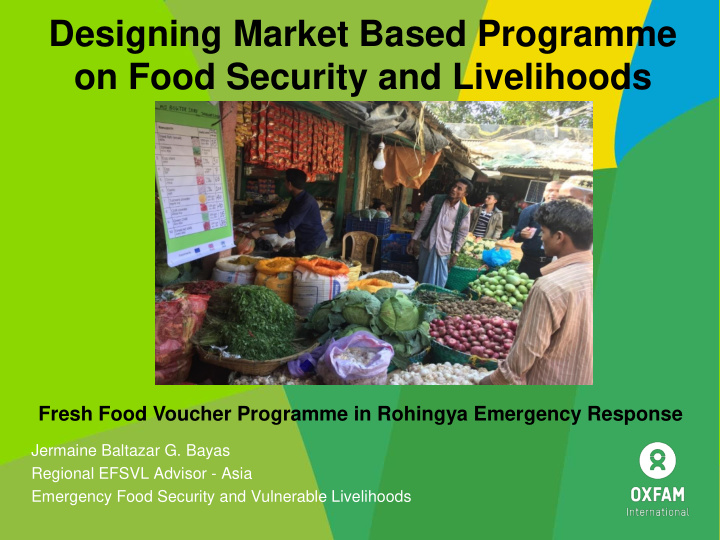



Designing Market Based Programme on Food Security and Livelihoods Fresh Food Voucher Programme in Rohingya Emergency Response Jermaine Baltazar G. Bayas Regional EFSVL Advisor - Asia Emergency Food Security and Vulnerable Livelihoods
Rapid Protection, Food Security & Market Assessment Oxfam conducted the assessment on November 2017: -to inform programming and wider humanitarian response. -to complement a large-scale WASH response -used the Oxfam 48 hour assessment tool as basic guide.
Oxfam 48 Hour Assessment Tool The tool is designed to collect very rapid and good enough assessment information to inform a response. Four sections: 1. Community and Household Focus Group Discussion Section on Food Security, Livelihoods, WASH, Markets and Cash delivery mechanisms 2. Markets and Traders Status After the Disaster: Questions for Traders 3. Cash Delivery Structures: Questions for Money Transfer Agents Coordination and Other Actors’ Response Plans 4.
Oxfam 48 hour Assessment Tool Analytical steps Situation Analysis Response Analysis • Identify initial set of • Answer who needs appropriate responses assistance, where, how much, when and for how • Narrow down and identify long appropriate responses considering agency specific context 48hr Questionnaire 48hr Decision Tree and Guidance Notes 48hr Response Options
Geographical Coverage of Assessment
Key Findings: Food Security and Coping Strategies Dietary diversity is low for both the refugees and host communities, only reaching three to four food groups per day (12 food groups). Access to meat, fish and eggs is extremely limited while fruits and dairy consumption is almost non-existent. Populations engaging in corrosive coping mechanisms in order to combat protection risks and threats such as reduction of food intake, as well as the re-sale of humanitarian assistance and borrowing in order to access more diverse food and other essential items.
Market Snapshot for Critical Items High level of market functionality around camps in Ukhia and Teknaf. 82% of host community traders said they could meet a 100% increase in demand. 92% of host community traders expressed an interest to take part in a humanitarian voucher programme.
Gender, Protection & Risk Analysis
Response Analysis 1. Livelihoods Appropriate Responses: Those actions that meet the needs gap of the affected population (survival or livelihood protection) and/or builds resilience. 2. Agency-Appropriate Responses: Actions that meet the implementing agency’s goals and capacities, and fit the humanitarian operating context (markets, risk, gender and protection)
48hr Decision Tree • Guidance to identifying potential responses based on available information • Can use a mixture of responses – it does not have to be just one
Response: Fresh Food Voucher Programme • Purchase vegetables, sugar, dried fish, egg and spices . Excluding staples - Rice, veg. oil and lentils (Provided by WFP and Govt) Average HH 730 BDT Large HH (8+ pax) 1170 BDT • Vouchers given once a month • Redeemable at Oxfam accredited local traders - 30 participating host community vendors across Households can choose WHEN 3 main markets they go to buy items, WHAT items • To date, 24,500 HHs (122,500 they buy and WHICH shop they individuals) reached monthly want to buy from! since the pilot in January 2018.
Key PDM Findings (August Monitoring and Feedback PDM) • 96% of respondents reported being very satisfied with the intervention. • 99% respondents said they feel safe traveling to the market; • 67% shared that it is the mother/wife who decides on what items to get; 97% of respondents feel the vendor treated them Data collection conducted 5-17 August; 388 HH sample size (using 95% level of with respect. confidence and 5% margin of error);
Ke Key Le Lear arnings nings • Identifying appropriate responses can be challenging. The use of the Decision Tree and Response Menu will help by taking the user step by step through the options • The Decision Tree and Response Menu are just guides and may not be applicable for all contexts • Complementary analysis tools and studies can be used to provide more information on what the responses look like and what their objectives are. (Cash SOP, MBP Framework, ECHO Decision Tree etc.) • Some tools need to be adapted to the context to ensure that affected population can relate to the questions which are vital for relevant and effective response analysis.
Thank you! https://www.oxfam.org/

Recommend
More recommend